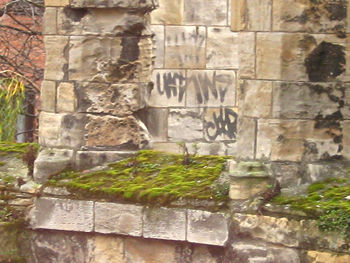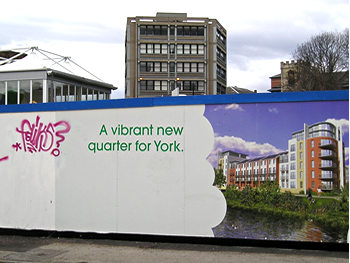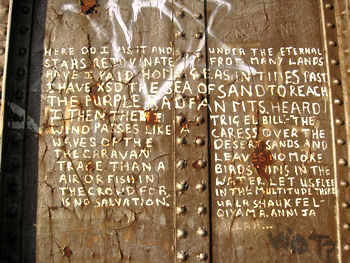February 2011
Tagging, etc
Moving on from the colourful and often carefully planned type of wall decoration, with its self-defined (though fluid and variable) boundaries, we meet the inevitable scribbling and random tagging. This is more annoying to most people. Particularly this kind of thing:

Graffiti on St Leonard’s Hospital remains, Library Square, November 2010
This shows graffiti on the inner wall of the ruins of St Leonard’s hospital, taken from a first-floor window at the library (taken through the glass, hence the fuzziness). Daubing paint on historic stone is a dumb and useless thing to do, in most people’s eyes.
Presumably this kind of thing is fairly rare, unless it’s that the authorities are so quick to clean it off most of us don’t get to see it. But I’d like to think it’s rare.
The widespread and more recent blight of mindless ‘tagging’ is being monitored, and has its own website. Tagging reminds me of the way male cats scent-mark any important corner in their territory by lifting their tail and urinating against it. So on lamp-posts and the like, and bits of random wall in the city and its suburbs, we see mindless doodlings, one colour, with usually no artistic merit, but presumably of great meaning to the sprayer/dauber, signifying something. Perhaps signifying the confusions of adolescence, in many cases, and a feeling of being angry and disillusioned and disenfranchised? I can remember those days.

Hoardings in the Hungate development, April 2008
These hoardings on the Hungate redevelopment site displayed advertising promising a bright future: ‘a vibrant new quarter for York’. Perhaps the person who doodled the purple shape to the left of this felt alienated and disenfranchised by this vision of unaffordable housing. In the background looms Stonebow House, like a grim warning, reminding us of what visions of the bright new future threw up nearby some decades ago.
I guess we must remember that graffiti is as old as the hills. Even the Romans did it (and I’m not just thinking of that funny bit in the Monty Python film ‘Life of Brian’). All kinds of people have left scribbled comments behind them, wanting to leave a mark, carved on stone, on trees, on toilet walls, on walls about to be papered, on bridges, under bridges.
Bridges seem to be particularly popular – as shown some years back in photos of a footbridge in the Holgate area. There’s also the constantly graffiti-covered bridge over the railway line by the hospital. The authorities paint it over in grey or cream paint, and it’s just a nice clean canvas for new graffiti. Which is usually inoffensive, the same old declarations of love, occasionally someone being called ‘a slag’. I’m surprised young people still bother with this kind of thing, in the age of Facebook and Twitter.
In recent years I haven’t noticed any really offensive graffiti of the ‘[particular ethnic group] go home’ variety. This might be because, rightly, covering up such graffiti is the priority. The council’s website states that they’ll aim to remove ‘offensive graffiti’ within 24 hours, and ‘Non offensive graffiti’ within four days.
(Apart from the obviously offensive racist daubings, I’d love to know how they decide what’s offensive and what isn’t. Perhaps they have a list they go through with you when you ring up?: ‘What does it say – ‘bum’? That’s classed as non-offensive. It would be category one if it said arse.’ ?)
Political, poetical, intellectual and philosophical
I’ve noticed fewer political or philosophical slogans – there were many of these a few years back – some recorded on previous pages. And going further back still, somewhere in York, years ago, I recall a brick wall – it might have been where the railway line goes under Bootham – that had ‘WORK EAT CONSUME DIE’ in white paint. In the 80s, graffiti on brick walls in town was often political – an angry public statement. Such as the ‘No Cruise’ slogan in the background of one of my dad’s photos of 80s buses.

Graffiti, Fisher of Dreams bridge, cycle track to Selby, July 2009
This interesting example of the more ‘thoughtful’ graffiti was – perhaps still is – on the bridge near Bishopthorpe, a bridge that used to carry trains and now carries cyclists and walkers from one bank of the Ouse to the other. It’s the home of the sculpture ‘The Fisher of Dreams’.
Another bridge covered in graffiti. I noticed the ‘Bishy Bikers’ had painted their name on the iron struts overhead. Among the general daubings was this lengthy piece of mysterious prose.
Graffiti can be very annoying, and I say this as someone who has had to clean it off a wall. It would be a mistake though to lump all of it together, and it seems a lot of time and effort is spent tackling it in areas where there’s really no need. I know I wasn’t alone in being rather bemused and indeed irritated by the pointless painting over of some of the artwork on the cycle track underpass. By now it will no doubt have been decorated more imaginatively again, and perhaps painted over again by a publicity-seeking councillor with a tin of grey paint, and then decorated again, painted grey again, and so it goes on. A waste of time, and indeed paint.
It’s obviously a real headache for the local authorities. Perhaps we could save them some money by accepting that certain bridges and underpasses in York will always be covered with random doodlings and declarations of love, and perhaps even colourful and imaginative pieces of art. They have been for as long as I can remember.
It’s painted over partly because it’s seen as somehow leading to other antisocial behaviour, though that theory doesn’t hold for me. ‘The presence of graffiti increases the perception of an unsafe area of crime’, says the TAAGY website. Does it?
It’s also seen as not showing the city in its best light for tourists. Again, not convincing – it’s unlikely they’ll be overly offended by a bit of paint on a wall. Presumably they’ve seen such things before, as graffiti is an inevitable ‘blight’ on every town and city.
Spray-painted graffiti tends to have a short life. I’ve encountered more long-lasting ‘graffiti’ all over the place, carved into trees, stone bridges out in the countryside, or on the walls of village churches and suburban chapels.





Thank you for adding a comment. Please note that comments are moderated, but should appear within 24 hours.